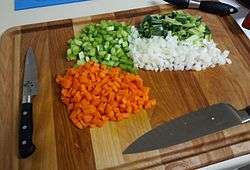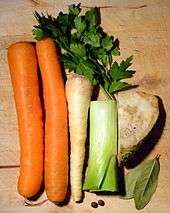Mirepoix (cuisine)

A mirepoix (/mɪərˈpwɑː/ meer-PWAH; French pronunciation: [miʁˈpwa]) is a flavour base made from diced vegetables that are cooked, usually with butter or oil or other fat, for a long time on a low heat without colour or browning. It is not sautéed or otherwise hard cooked because the intention is to sweeten the ingredients rather than caramelise them. It is a long-standing cooking technique in French cuisine. Further cooking, often with the addition of tomato purée, creates a darkened brown mixture called pincage (French: pinçage).
When the mirepoix is not precooked, the constituent vegetables may be cut to a larger size, depending on the overall cooking time for the dish. Usually the vegetable mixture is onions, carrots, and celery (either common pascal celery or celeriac), with the traditional ratio being 2:1:1, two parts onion, one part carrot, and one part celery.[1] Mirepoix is the flavour base for a wide variety of Western dishes: stocks, soups, stews and sauces.
Similar flavour bases include the Italian soffritto, the Spanish sofrito, refogado/sufrito (braised onions, garlic and tomato) from Portuguese-speaking nations, the German suppengrün (leeks, carrots and celeriac), the Polish włoszczyzna (leeks, carrots, celery root and parsley root), the US Cajun / Creole holy trinity (onions, celery and bell peppers), and possibly the French duxelles (mushrooms and often onion or shallot and herbs, reduced to a paste).
History
Though the cooking technique is probably older, the term "mirepoix" dates from the 18th century and derives, as do many other appellations in French cuisine,[2] from the aristocratic employer of the cook credited with establishing and stabilizing it: in this case,[3] Charles-Pierre-Gaston François de Lévis, duc de Lévis-Mirepoix (1699–1757), French field marshal and ambassador and a member of the noble family of Lévis, lords of Mirepoix in Languedoc since the 11th century.[4] According to Pierre Larousse (quoted in the Oxford Companion to Food), the unfortunate Duke of Mirepoix was:
"an incompetent and mediocre individual...who owed his vast fortune to the affection Louis XV felt toward his wife and who had but one claim to fame: he gave his name to a sauce made of all kinds of meat and a variety of seasonings"
The term is not encountered regularly in French culinary texts until the 19th century, so it is difficult to know what a dish à la mirepoix was like in 18th-century France. Beauvilliers,[5] for instance, in 1814, gives a short recipe for a Sauce à la Mirepoix which is a buttery, wine-laced stock garnished with an aromatic mixture of carrots, onions, and a bouquet garni. Carême, in the 1830s, gives a similar recipe, calling it simply Mire-poix; and, by the mid-19th century, Gouffé refers to a mirepoix as "a term in use for such a long time that I do not hesitate to use it here". His mirepoix is listed among essences and, indeed, is a meaty concoction (laced with two bottles of Madeira), which, like all other essences, was used to enrich many a classic sauce. By the end of the 19th century, the mirepoix had taken on its modern meaning and Joseph Favre in his Dictionnaire universel de cuisine (circa 1895, reprinted 1978) uses the term to describe a mixture of ham, carrots, onions, and herbs used as an aromatic condiment when making sauces or braising meat.[6] The matignon[6] is very similar to the mirepoix, except that the matignon is designed to be brought to the table and eaten with the dish or alone as a side dish.
According to the 1938 Larousse Gastronomique, a mirepoix may be prepared "au gras" (with meat) or "au maigre" ("lean").[7] Mirepoix au maigre is sometimes called a brunoise[8] (though strictly speaking this term more accurately merely designates the technique of cutting into small dices with a knife). A mirepoix au gras contains diced ham or pork belly as an additional ingredient. Similar combinations, both in and out of the French culinary repertoire, may include leeks, parsnips, garlic, tomatoes, shallots, mushrooms, bell peppers, chilies, and ginger, according to the requirements of the regional cuisine or the instructions of the particular chef or recipe.[9] The analogous soffritto (frequently containing parsley) is the basis for many traditional dishes in classic Italian cuisine, and the sofrito serves a similar purpose in Spanish cuisines. In Cajun and Creole cuisine, a mirepoix or (jocularly so-called) "holy trinity" is a combination of onions, celery, and bell peppers.
Traditionally, the weight ratio for mirepoix is 2:1:1 of onions, celery, and carrots;[1] the ratio for bones to mirepoix for stock is 10:1. When making a white stock, or fond blanc, parsnips are used instead of carrots to maintain the pale color.
International versions
German Suppengrün
Suppengrün [ˈzʊpm̩ˌɡʁyːn] means soup greens in German, and the Dutch equivalent is soepgroente. Soup greens usually come in a bundle and consists of a leek, a carrot, and a piece of celeriac. It may also contain parsley, thyme, celery leaves, rutabaga (swede), parsley root, and onions. The mix depends on regional traditions, as well as individual recipes. The vegetables used are cold-climate roots and bulbs with long shelf lives. Suppengrün act as herbs and impart hearty, strong flavors to the soup or sauce, providing a foil for other strong tasting ingredients such as dried peas and beans or pot roast.[10] Large chunks of vegetables are slow cooked to make flavorful soups and stocks, and are discarded when the vegetables have given up most of their flavor. Finely chopped suppengrün are browned in fat and used as a basis for a finished sauce. The vegetables may also be cooked long enough until they fall apart, and may become part of the sauce or pureed to form the sauce.
Italian soffritto
The Italian version of mirepoix is called soffritto (not to be confused with the Spanish sofrito or Portuguese Refogado / Sufrito), a base of finely chopped parsley and onion sauteed in lard, but most modern cooks substitute olive oil or butter. Garlic, celery, or carrot may also be included.[11]
According to the Italian restaurateur Benedetta Vitali, soffritto means "underfried" and describes it as "a preparation of lightly browned minced vegetables, not a dish by itself." At one time it was called "false ragout", because soffritto was thought to vaguely recall the flavor of meat sauce.[12]
Polish włoszczyzna

Włoszczyzna [vwɔʂˈt͡ʂɨzna] is the Polish word for soup vegetables or greens. The word literally means "Italian stuff" because Queen Bona Sforza, who was Italian and married Polish King Sigismund I the Old in 1518, introduced this concept to Poland.[13] A włoszczyzna may consist of carrots, parsnips or parsley root, celery root or celeriac, leeks, and savoy or white cabbage leaves, and sometimes celery leaves and flat-leaf parsley. The most typical, packaged combination is celery root, parsley root, carrots, and leeks. Włoszczyzna is usually cut up to uniform size and boiled to form a flavour base for soups and stews.
References
- 1 2 The Culinary Institute of America (2011). The Professional Chef (9th ed.). Hoboken, New Jersey: John Wiley & Sons. ISBN 978-0-470-42135-2. OCLC 707248142.
- ↑ Vitaux, Jean. "Peut-on écrire l'histoire de la gastronomie?". canalacademie.com (in French).
- ↑ "Petit lexique culinaire". chefsimon.com (in French). Archived from the original on 2007-01-18.
- ↑ French Wikipedia: Maison de Lévis.
- ↑ See subsection, "Dining Out", a history of the restaurant, in Wikipedia entry for French cuisine.
- 1 2 Alan Davidson, Oxford Companion to Food (Oxford: Oxford University Press, 1999), p. 509.
- ↑ Since the 17th century, recipe books in France had been organized so readers could plan meals in accordance with prescribed days for fasting according to the Roman Catholic liturgical calendar. See Sean Takats, The Expert Cook in Enlightenment France (Baltimore, Maryland: Johns Hopkins University Press) p. 110.
- ↑ Larousse Gastronomique, Montagné, Prosper, and Gottschalk, eds., introduction by A. Escoffier and Philéas Gilbert (Paris: Librerie Larousse, 1938), p. 690.
- ↑ The 1938 Larousse (op. cit) recommends the addition of thyme and powdered bay leaf to the mirepoix au maigre, for example.
- ↑ "Use Carrots, Onions and Leeks for German Soup Greens".
- ↑ Hazan, Marcella (2011-07-20). Essentials of Classic Italian Cooking (Kindle Location 168). Knopf Doubleday Publishing Group. Kindle Edition.
- ↑ Benedetta Vitali, Soffritto: Tradition and Innovation in Tuscan Cooking (Berkeley, Toronto: Ten Speed Press, 2001), pp. 7–8.
- ↑
External links
| Wikibooks Cookbook has a recipe/module on |